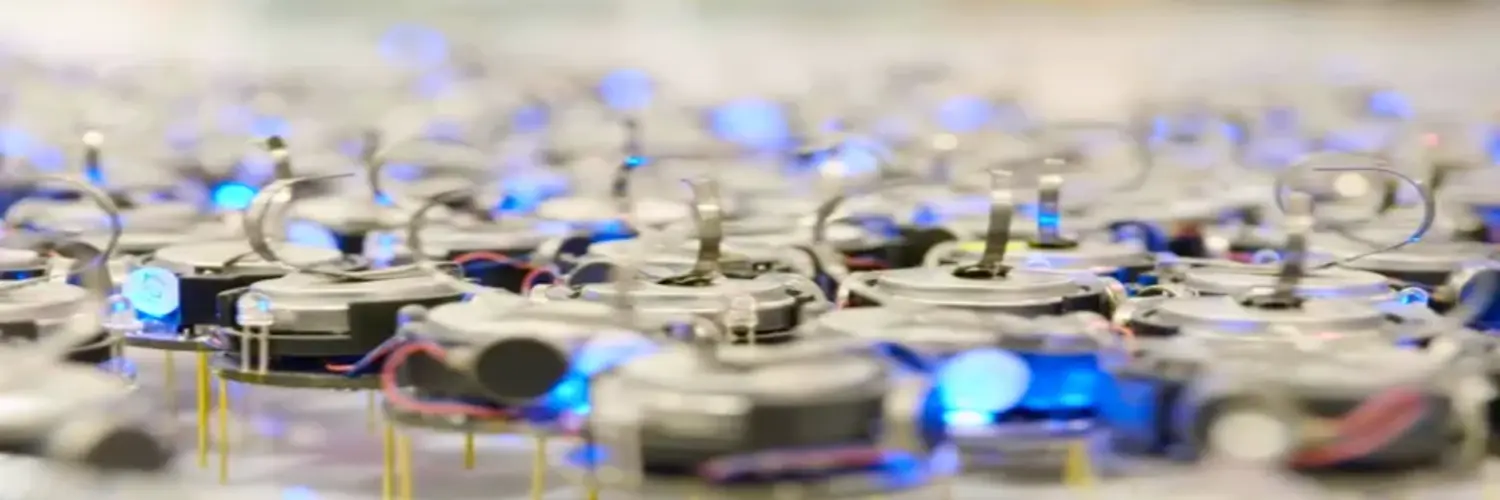Swarm robotics is a new branch of robotics and artificial intelligence that draws inspiration from biological systems including ant colonies, flocks of birds, and schools of fish. The idea is that many basic robots collaborate to complete intricate tasks that would be impossible or very difficult for one robot to complete on its own. Swarm robots, which uses decentralized control, local communication and emergent behavior, has the potential to change industries ranging from agriculture to disaster response.
The Foundations of Swarm Robotics
The principles behind swarm robotics are derived from the study of swarm intelligence, a subset of artificial intelligence focused on the collective behavior of decentralized, self-organized systems. This technique depends on the following fundamental characteristics:
- Decentralization – Unlike traditional robotics, where a central controller dictates motions and choices, swarm robotics relies on individual robots to operate independently with minimum coordination.
- Scalability – Swarm systems can expand and contract effortlessly, giving for greater deployment flexibility.
- Robustness – The system stays operational even when some robots fail, ensuring resilience in complicated contexts.
- Self-Organization – The swarm’s collective intelligence is derived from simple rules regulating individual robots.
These ideas enable swarm robotics to perform well in unpredictable and dynamic contexts.
Technologies Enabling Swarm Robotics
Several technological breakthroughs contribute to the increasing feasibility of swarm robotics:
- AI and Machine Learning – AI algorithms enable robots in decision making, navigation and problem solving.
- Wireless Communication – Robots can exchange data and plan jobs thanks to technologies like Bluetooth, Wi-Fi and radio frequency.
- Sensor Networks – Cameras, LiDAR, infrared, and ultrasonic sensors enable robots to detect and adapt to their surroundings.
- Edge Computing – Processing data locally on robots minimizes the need for centralized servers, increasing efficiency and lowering latency.
- Bio-Inspired Algorithms – Algorithms modeled after natural behaviors, such as ant colony and particle swarm optimization, allow robots to do tasks more efficiently.
Applications of Swarm Robotics
There are several potential uses for swarm robots in a variety of industries, some of which include:
1. Agriculture
Autonomous robotic swarms can help with precision farming, including planting, watering, pest control and harvesting. By increasing efficiency, these robots lessen the need for chemical pesticides and fertilizers.
2. Search and Rescue Missions
Swarm robots can be deployed in disaster stricken areas to locate survivors, assess damage and deliver essential supplies. Even in the event that some units are lost, their dispersed structure guarantees mission continuance.
3. Military and Defense
Swarm drones and robotic units can be used for reconnaissance, surveillance, and offensive operations. They can collect intelligence while lowering the risk to humans and independently traverse enemy territory.
4. Healthcare
Nanorobotic swarms hold promise in targeted drug delivery, minimally invasive surgeries, and disease detection. These microscopic robots can navigate the human bloodstream to treat ailments with unparalleled precision.
5. Environmental Monitoring
Swarm robots can be used to clean up hazardous waste in forests and oceans, track climate change, and keep an eye on pollution levels.
6. Construction and Infrastructure
In building projects, swarm robots can be used to automate processes like 3D printing, welding, and bricklaying. They can also inspect and maintain critical infrastructure such as bridges and tunnels.
Challenges in Swarm Robotics
Despite its potential, swarm robots confronts a number of hurdles that must be overcome before broad adoption:
- Coordination Complexity – Ensuring flawless coordination among hundreds or thousands of robots is a major task.
- Communication Limitations – In order to enable real-time collaboration, wireless communication needs to be dependable and effective.
- Energy Efficiency – Small robots have limited power sources, making battery life a crucial factor.
- Security Risks – Swarm robots are susceptible to hacking and cyber threats, potentially compromising their mission.
- Ethical and Legal Considerations – Applicable regulations are required to handle the ethical difficulties generated by the deployment of autonomous swarms in key areas such as healthcare and defense.
The Future of Swarm Robotics
As technology progresses, swarm robotics will become more efficient and adaptable. To bring swarm robots to the general public, researchers are looking into stronger security measures, better energy solutions and more AI driven coordination. Deep space exploration, completely automated industrial ecosystems and autonomous cities are possible future uses.
Conclusion
Swarm robotics represents a groundbreaking approach to problem-solving through decentralized collaboration. It is a field of robotics that has the ability to transform industries and handle global concerns, and it promises to impact the future of automation. As science and technology develop, we can expect to see swarms of intelligent robots collaborating with people to create a smarter and more efficient environment.

